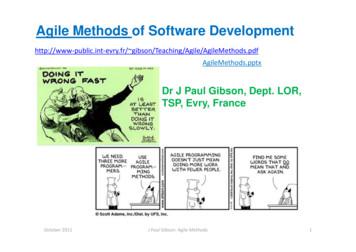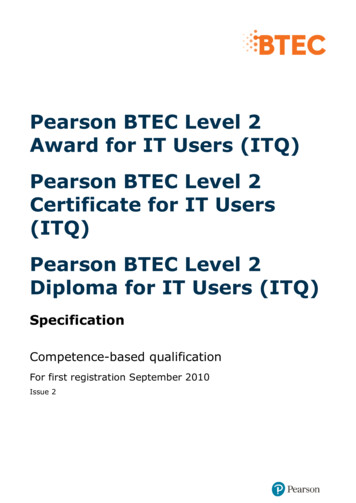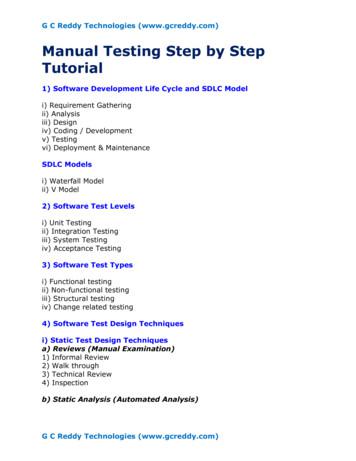Purpose: Introduction Software
Lab on The Series RL, RC and RLC Circuit and ResonancePurpose:1. To measure the value of a capacitor C and Inductor L using a series RC & RL circuits, in series with a sinusoidal voltagesource.2. To study the phase relationships between Voltage and Current for R, L and C.3. To measure the resonance frequency of a series RLC circuit and compare with the theoretical value.IntroductionThis online lab exercise will allow you to simulate the time dependence of the current in a series RL circuit, a series RCcircuit and finally a series RLC circuit, in each case driven by an alternating voltage source, using the online circuitbuilding tool at www.falstad.com/circuit. You will be able to view the time dependence of the voltage and current (andtheir phase relationship) for all 3 components in the circuit.The simulator also allows you to change the values of R (resistance), C (capacitance), and L (inductance) and observeresulting changes in the resonant frequency of the series RLC circuit.SoftwareThis lab runs in any web browser. Google Chome is recommended. It can be run online or downloaded for offlineviewing. The web address is: www.falstad.com/circuitYou can download an offline version as follows:Mac: http://falstad.com/circuit/CircuitJS1.dmgMS Windows: ng the program allows it to work faster and you may encounter fewer delays caused by network speed. If youdo not want to download it, you can work online on the website. Whether running online or offline, the actualprocedure of conducting the simulation and analysis is the same.Running the experimentOpen the program: circuitjs1.exe (Or circuitjs1.dmg for mac, Or use the online version).Part 1, Measuring C1) Click Circuits in the top menu and click A/C circuits, then select Capacitor.2) Let’s set the capacitor value, C 2 µF. To do this, move the mouse over the capacitor till its color becomes light blue,then right click it and edit and put the value as 2 micro Farads, i.e. type 2u (and it already knows that the unit is F:Farad)and click apply then click OK.Now, let’s set the resistance value, R 200 Ohms. To do this, move the mouse over the Resistor till its color becomeslight blue, then right click it and edit and put the value as 200 (and it already knows that the unit is W) and click applythen click OK. This1
Finally, let’s set up an AC voltage source with amplitude 1 Volt and frequency 200 Hz, as follows: Move the mouse overthe Function Generator (the A/C voltage source), till its color becomes light blue, then right click it and change the valueof Max Voltage to 1 (and it already knows that the unit is v: Volts). Keep the type of the wave form as is (A/C), and putthe value of the frequency as 200 (and it already knows that the unit is Hz: Hertz). Keep the Phase offset (degrees) as is(the default of zero), and then click apply then click OK.3) Let’s set up the way in which the waveforms are displayed at the bottom of the screen (the “Dock). In the graph area,at the bottom, click the gear icon (or right click in that area), and set the scroll speed to 2 ms/div (using the arrow).4) To view the properties of the resistor, voltage source and capacitor: move the mouse over the Resistor until its color becomes light blue, then right click it and edit and select view inscope. Do the same for the function generator (the A/C voltage source). The scope for the capacitor voltage is already available at the bottom (the Dock). If you have deleted byaccident, view it in the scope as well by doing the same procedure as for the resistor and function generator.Make the Simulation speed medium, in the upper right corner, then click Run/Stop, and after about 4 cycles, click theRun/Stop again to stop the running.5) Move the mouse to: the graph of the capacitor output in order to find the value of the voltage at a peak (say the third peak), and alsorecord the time at that peak, tV,C. Note that if you want to increase the number of decimal places in the timereading you can decrease the scroll speed per div(ision) in the properties of each graph (this makes the timescale more sensitive).the resistor graph to do the same thing, i.e. find the peak value of the voltage across the resistor, and the timeat that peak, tV,R. Make sure that you examine the same peak for the capacitor and the resistor. In otherwords, if you are looking the 3rd set of peaks for the capacitor, you must also look at the 3rd peak for the resistor.This is so that you can compare times within the same cycle.We expect that 𝐶 # ,&'(#),&'( ,-where 𝜔 2𝜋𝑓, 𝑓 is the frequency, in this procedure 𝑓 200 Hz.From the above formula, calculate the “observed” value of capacitance, C and compare it with the capacitance that youset, which was 2 µF.Figure 1: Example RLC circuit (top) with an AC voltage source. Graphs of the voltage across, and current through, the threecomponents in the circuit are shown in the “Dock” below the circuit diagram.2
6) Calculate the difference in the times you recorded in step 5 above for the peaks of VR and VC: 𝑡 𝑡#,- 𝑡#,7Using this time, find the phase difference (phase angle) between VR and VC by using the equation: 𝜙 𝜔 𝑡 2𝜋𝑓 𝑡You should find that, for the resistor the voltage curve and the current curve are in phase (i.e. 0 phase difference) and soyou cannot “see” the voltage and current curves separately, as they overlap perfectly. But IR VR/R, so IR should be ofdifferent magnitude to VR. The simulator plots VR and I R on top of each other which is probably a problem thatsometimes occurs with the simulator. It is true that they are in phase, but they have different values. If you want to seeIR, right click the graph of R and select properties and uncheck show voltage and leave show current checked.Part 2, Measuring L1) You will now repeat the procedures of part 1, but with an inductor. Open the program, Click Circuits and click A/Ccircuits and select inductor (instead of capacitor). Set up a 0.1 Henry inductor by changing the value of the inductor to0.1 (and it already knows that it is in H: Henry). The resistor can be 200 Ohms, as before. The power source should alsohave the same maximum voltage (1 Volt) and frequency (200 Hz) as before.Observe the maximum in the voltage across the inductor, 𝑉:,; and, again, the maximum in the voltage across theresistor, 𝑉-,; .#-To “find” L, we can use the theoretical equation 𝐿 # ?,&'( , . Compare your finding with the value that you set ,&'((0.1 H).2) As in Part 1, find the phase angle (phase difference) between the voltage of the inductor and the voltage of theresistor. Again, make sure to examine the same peaks in the “scope” output for an accurate comparison of the timewithin the same cycle. Which voltage is leading? Is VL leading VR or is VR leading VL?Part 3, Resonance in a series RLC circuit1) Click Circuits in the top menu, then A/C then select Capacitor. Set thevalues as shown in Figure 3. The max (peak) voltage for Vsource shouldnow be 5 Volts.We are going to delete the bottom wire and replace it by an inductor L.To do that, move the mouse to the bottom wire and right click and selectdelete. Then, Click Draw in the top menu and select Passive componentsand select Add inductor. Place it in the place of the wire that we deletedby clicking and dragging from the bottom end of the capacitor to thebottom end of the voltage source. Make sure that the inductor windingsare as shown in Figure 3; if not then right click the inductor and selectswap terminals. Change its value to 0.1 (it knows the unit: H).3Figure 2: resistor and capacitance values forPart 3, shown before adding an inductor
So as not to keep adding more inductors, in Draw select the last item Select/Drag Sel. Now the mouse is back to normal.2) Click the settings of the graph in the bottom Dock and change the Scrollspeed to 2ms/ div. Move the mouse to the inductor until its color becomes lightblue, and right click it and select view in scope, and do the same for the resistor.This is to show the voltage wave form across the inductor (green curve) andalso the current wave form in the inductor (yellow curve) and voltage andcurrent for R. What is the relation of this current in R to the current in L and in Cin this circuit? Why?3) Run the simulator by clicking Run/Stop. Keep running the simulation until thecurves become smooth. You can increase the speed of the simulation usingFigure 3: the completed series RLC circuit, Simulation speed at the top right of the window. Stop the simulation by clickingshowing the 0.1 Henry inductor on theRun/Stop.bottomFigure 4: Scope traces for the three components in Part I3Measurement Find the peak value of the current (yellow curve) by placing the mouse on the peak of the yellow current curveand reading the value of the current displayed by the simulator at the peak, where you have placed the mouse.(Remember: the current through the circuit is the same for all 3 devices since they are in series!)Repeat this measurement of peak current with the frequency of the source changed to 300 Hz. Each time,record the peak (Maximum) of the current curve. You need to run, stop and then re-run for each separatemeasurement.Then repeat for f 356 Hz, f 400 Hz and 500 Hz. Finally try at f 350 Hz and then 360 Hz. Use the table below tolog the variation in peak current, Imax.Analysis(a) Plot a graph of the peak value of the current versus frequency. You can add more values of the frequency if youwant to, by taking more measurements as above. Find the “resonance” frequency from your graph – thefrequency at which the peak current is maximum – and compare with the calculated resonance frequency forthis circuit using𝑋: A BCD 𝑋7 A BCD 𝑓BCDFG GHC IJ :7.(b) For any frequency (say 100 Hz), find the phase difference angle between the voltage across L (VL), and thevoltage across C (VC), by recording the times of corresponding peaks (same peaks, say the first peak after thevertical line of the y axis in both graphs) using the mouse and then using 𝜙 𝜔 𝑡 2𝜋𝑓 𝑡. As in the rest ofthis lab, you must use same corresponding peaks to be able to find corresponding phase difference. Toemphasize, same corresponding peaks mean: if you use the first ve peak of VC after the vertical line of the y4
axis you must also use the first ve peak of the VL after the vertical line of the y axis to record the correctcorresponding times to find 𝑡. You can run and stop the simulator until you are able to see simultaneouslydisplayed in the scopes the same corresponding peaks for VC and VL voltages (green curves for C and L), as in theexample shown in Figure 4. Which is leading VL or VC? Note that if Dt 0 s, then something is wrong. Review step1 in part 3 concerning the windings of the inductor.(c) What is the phase difference between the IR, the current through the resistor and the VR, the voltage across R?f (Hz)100300350356360400500Max (peak) currentfresonance from graph . Hzfresonance from calculation . HzShow your work for fresonance calculation:You can copy this table and values into your lab report along with all the other requirements of the labreport: the graphs of all parts, calculations, .etc.5
Lab on The Series RL, RC and RLC Circuit and Resonance Purpose: 1. To measure the value of a capacitor C and Inductor L using a series RC & RL circuits, in series with a sinusoidal voltage . circuit and finally a series RLC circuit, in each case driven by an alternating voltage source, using the online circuit-
tres tipos principales de software: software de sistemas, software de aplicación y software de programación. 1.2 Tipos de software El software se clasifica en tres tipos: Software de sistema. Software de aplicación. Software de programación.
The IC Dedicated Support Software is described in Section 1.4.3.2. 1.3.1.2 Security Software The IC Dedicated Software provides Security Software that can be used by the Security IC Embedded Software. The Security Software is composed of Services Software and Crypto Library. The Services Software consists of Flash Services Software, Services .
1.1 Introduction 1.2 Context 1.3 Purpose and scope 1.4 Language and terms Chapter 1: Introduction to essential health services 1.1 Introduction 1.2 Purpose & scope 1.3 Language and terms Chapter 1: Introduction to essential justice and policing services 1.1 Introduction 1.2 Purpose & scope 1.3 Language and terms Chapter
Application Software: High-level software that is unique to the application(s) for which the embedded computer (i.e. subsystem) exists 80-90% of the total software (in terms of long-term development cost) Software Execution Platform: Low-level software, the purpose of which is to allow the Application Software to run on the hardware
Software Process Capability is the range of expected results that are achievable by following the software process. 1. Software Processand the Software Life Cycle October 2011 J Paul Gibson: Agile Methods Software process performance is the actual result achieved in the development of software by following a software process.
Unit 322: Drawing and Planning Software 219 Unit 123: Desktop Publishing Software 222 Unit 223: Desktop Publishing Software 225 Unit 323: Desktop Publishing Software 228 Unit 124: Multimedia Software 231 Unit 224: Multimedia Software 234 Unit 324: Multimedia Software 237 Unit 125: Presentation Software
1) Software Development Life Cycle and SDLC Model Software Development Life Cycle Software Development Life Cycle is a systematic approach to develop software. It is a Process followed by Software Developers and Software Testing is an integral part of Software Development, so it i
Apr 26, 2010 · DO-178B Software Life Cycle Model Software QA Plan Software Planning Process Plan for Software Aspects of Certification Software Development Plan . Role of Testing in Software Verification Test cases are to be derived from software requirements Requirements-based hardware/


















